Abstract
Tuberculosis patients who are homeless, indigent, and alcoholic infrequently complete a course of chemotherapy, risking treatment failure, recurrence, and continued spread of infection in the community. Obstacles to successful treatment include an erratic schedule, mistrust of authority, and uncooperative or aggressive behavior. Successful management of this problem requires the use of proven case holding techniques, a correct choice of drug regimen, and a prompt and appropriate response to the patient who is lost or refuses treatment. Nine- and six-month drug regimens with proven success are now available; however, the direct observation of medication-taking should be maximized. Patient default may be further minimized by encouraging prompt notification of the health department. Occasionally, the threat or use of existing public health laws on confinement for purposes of treatment are required for noncompliant patients.
Full text
PDF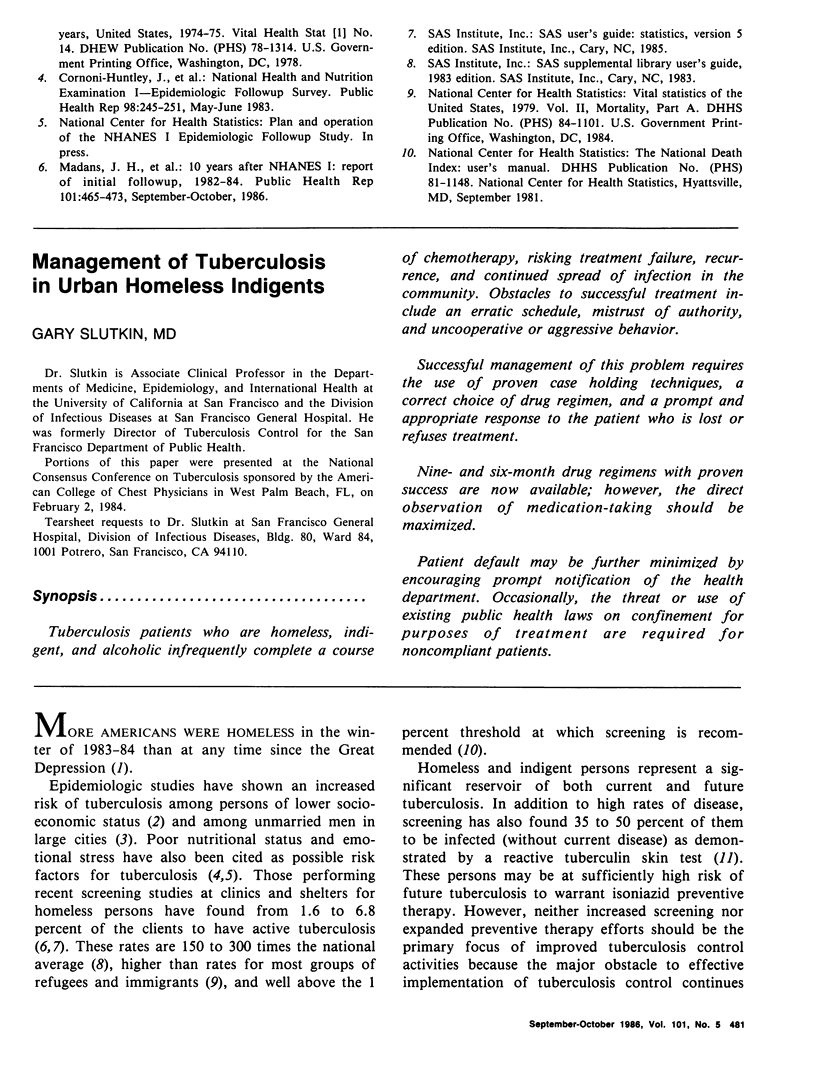
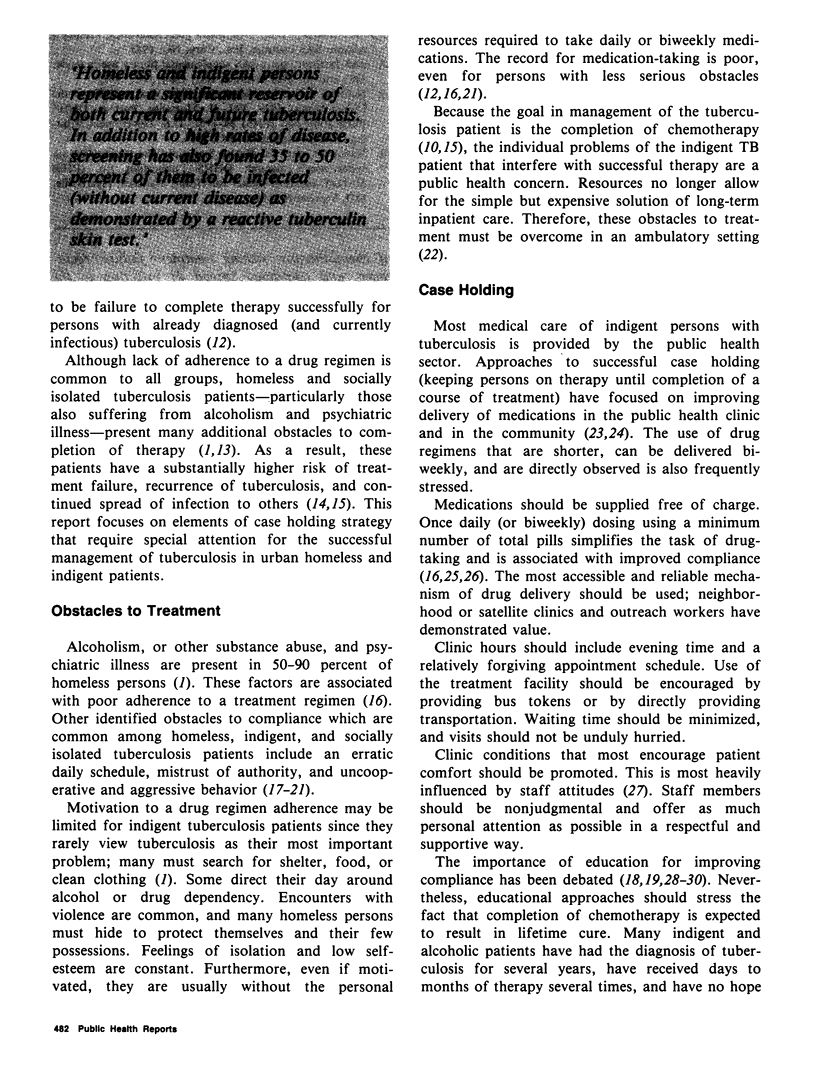
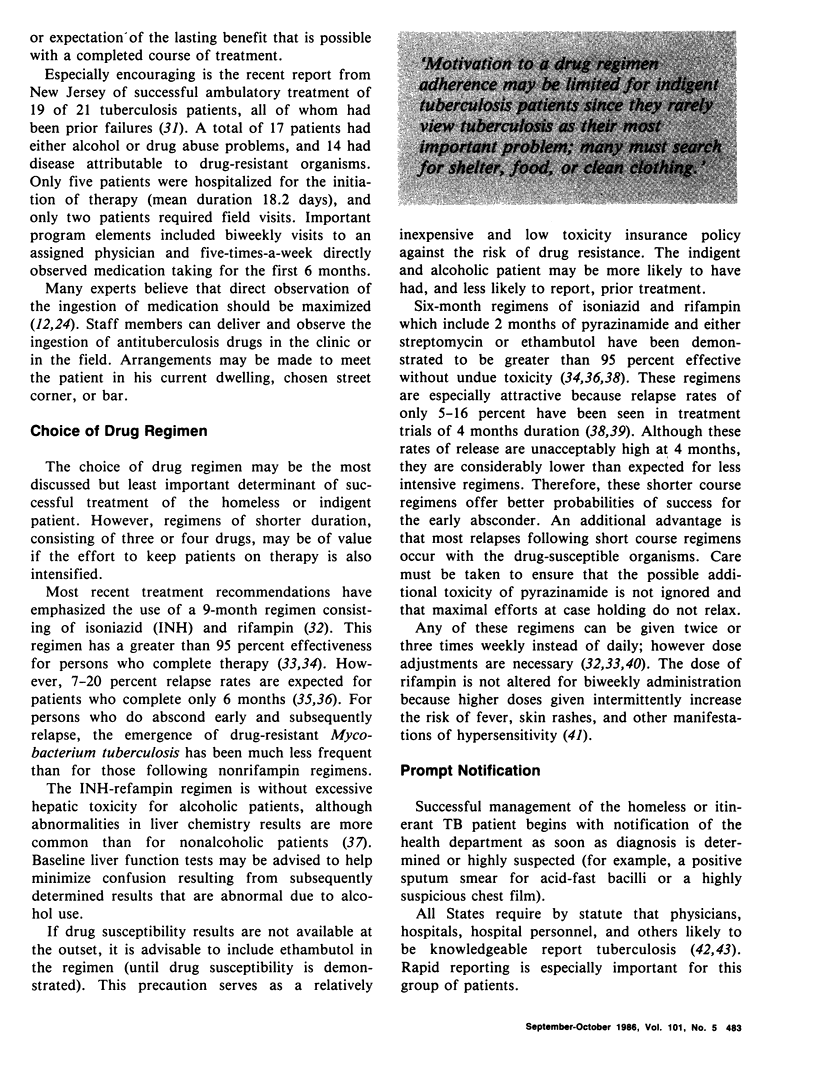
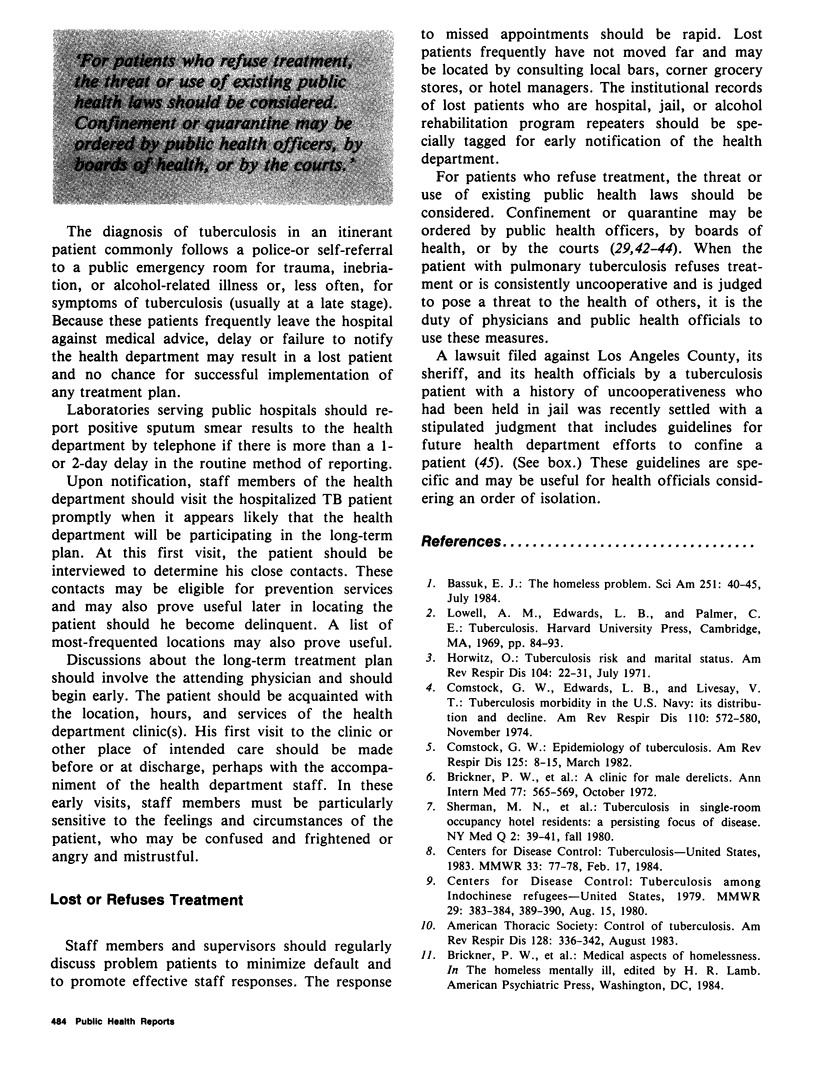
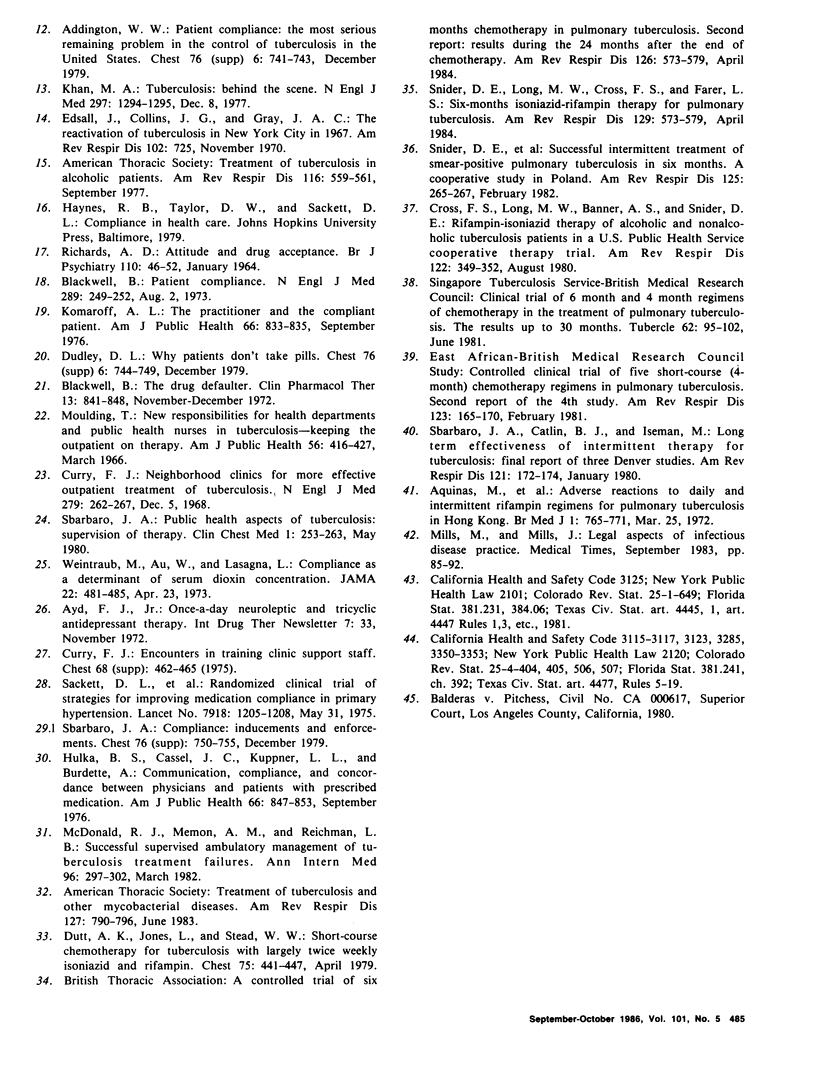
Selected References
These references are in PubMed. This may not be the complete list of references from this article.
- Addington W. W. Patient compliance: the most serious remaining problem in the control of tuberculosis in the United States. Chest. 1979 Dec;76(6 Suppl):741–743. doi: 10.1378/chest.76.6_supplement.741. [DOI] [PubMed] [Google Scholar]
- Aquinas M., Allan W. G., Horsfall P. A., Jenkins P. K., Hung-Yan W., Girling D., Tall R., Fox W. Adverse reactions to daily and intermittent rifampicin regimens for pulmonary tuberculosis in Hong Kong. Br Med J. 1972 Mar 25;1(5803):765–771. doi: 10.1136/bmj.1.5803.765. [DOI] [PMC free article] [PubMed] [Google Scholar]
- Bassuk E. L. The homelessness problem. Sci Am. 1984 Jul;251(1):40–45. doi: 10.1038/scientificamerican0784-40. [DOI] [PubMed] [Google Scholar]
- Blackwell B. Drug therapy: patient compliance. N Engl J Med. 1973 Aug 2;289(5):249–252. doi: 10.1056/NEJM197308022890506. [DOI] [PubMed] [Google Scholar]
- Blackwell B. The drug defaulter. Clin Pharmacol Ther. 1972 Nov-Dec;13(6):841–848. doi: 10.1002/cpt1972135part2841. [DOI] [PubMed] [Google Scholar]
- Brickner P. W., Greenbaum D., Kaufman A., O'Donnell F., O'Brian J. T., Scalice R., Scandizzo J., Sullivan T. A clinic for male derelicts. A welfare hotel project. Ann Intern Med. 1972 Oct;77(4):565–569. doi: 10.7326/0003-4819-77-4-565. [DOI] [PubMed] [Google Scholar]
- Comstock G. W., Edwards L. B., Livesay V. T. Tuberculosis morbidity in the U.S. Navy: its distribution and decline. Am Rev Respir Dis. 1974 Nov;110(5):572–580. doi: 10.1164/arrd.1974.110.5.572. [DOI] [PubMed] [Google Scholar]
- Comstock G. W. Epidemiology of tuberculosis. Am Rev Respir Dis. 1982 Mar;125(3 Pt 2):8–15. doi: 10.1164/arrd.1982.125.3P2.8. [DOI] [PubMed] [Google Scholar]
- Cross F. S., Long M. W., Banner A. S., Snider D. E., Jr Rifampin-isoniazid therapy of alcoholic and nonalcoholic tuberculous patients in a U.S. Public Health Service Cooperative Therapy Trial. Am Rev Respir Dis. 1980 Aug;122(2):349–353. doi: 10.1164/arrd.1980.122.2.349. [DOI] [PubMed] [Google Scholar]
- Curry F. J. Encounters in training clinic support staff. Chest. 1975 Sep;68(3 Suppl):462–465. doi: 10.1378/chest.68.3_supplement.462. [DOI] [PubMed] [Google Scholar]
- Dudley D. L. Why patients don't take pills. Chest. 1979 Dec;76(6 Suppl):744–749. doi: 10.1378/chest.76.6.744. [DOI] [PubMed] [Google Scholar]
- Dutt A. K., Jones L., Stead W. W. Short-course chemotherapy of tuberculosis with largely twice-weekly isoniazid-rifampin. Chest. 1979 Apr;75(4):441–447. doi: 10.1378/chest.75.4.441. [DOI] [PubMed] [Google Scholar]
- Edsall J., Collins J. G., Gray J. A. The reactivation of tuberculosis in New York City in 1967. Am Rev Respir Dis. 1970 Nov;102(5):725–736. doi: 10.1164/arrd.1970.102.5.725. [DOI] [PubMed] [Google Scholar]
- Horwitz O. Tuberculosis risk and marital status. Am Rev Respir Dis. 1971 Jul;104(1):22–31. doi: 10.1164/arrd.1971.104.1.22. [DOI] [PubMed] [Google Scholar]
- Hulka B. S., Cassel J. C., Kupper L. L., Burdette J. A. Communication, compliance, and concordance between physicians and patients with prescribed medications. Am J Public Health. 1976 Sep;66(9):847–853. doi: 10.2105/ajph.66.9.847. [DOI] [PMC free article] [PubMed] [Google Scholar]
- Komaroff A. L. Editorial: The practitioner and the compliant patient. Am J Public Health. 1976 Sep;66(9):833–835. doi: 10.2105/ajph.66.9.833. [DOI] [PMC free article] [PubMed] [Google Scholar]
- McDonald R. J., Memon A. M., Reichman L. B. Successful supervised ambulatory management of tuberculosis treatment failures. Ann Intern Med. 1982 Mar;96(3):297–302. doi: 10.7326/0003-4819-96-3-297. [DOI] [PubMed] [Google Scholar]
- Mills M. Legal aspects of infectious disease practice. Resid Staff Physician. 1983 Sep;29(9):85-7, 90, 92. [PubMed] [Google Scholar]
- Moulding T. New responsibilities for health departments and public health nurses in tuberculosis-- keeping the outpatient on therapy. Am J Public Health Nations Health. 1966 Mar;56(3):416–427. doi: 10.2105/ajph.56.3.416. [DOI] [PMC free article] [PubMed] [Google Scholar]
- RICHARDS A. D. ATTITUDE AND DRUG ACCEPTANCE. Br J Psychiatry. 1964 Jan;110:46–52. doi: 10.1192/bjp.110.464.46. [DOI] [PubMed] [Google Scholar]
- Sackett D. L., Haynes R. B., Gibson E. S., Hackett B. C., Taylor D. W., Roberts R. S., Johnson A. L. Randomised clinical trial of strategies for improving medication compliance in primary hypertension. Lancet. 1975 May 31;1(7918):1205–1207. doi: 10.1016/s0140-6736(75)92192-3. [DOI] [PubMed] [Google Scholar]
- Sbarbaro J. A., Catlin B. J., Iseman M. Long-term effectiveness of intermittent therapy for tuberculosis: final report of three Denver studies. Am Rev Respir Dis. 1980 Jan;121(1):172–174. doi: 10.1164/arrd.1980.121.1.172. [DOI] [PubMed] [Google Scholar]
- Sbarbaro J. A. Compliance: inducements and enforcements. Chest. 1979 Dec;76(6 Suppl):750–756. doi: 10.1378/chest.76.6_supplement.750. [DOI] [PubMed] [Google Scholar]
- Sbarbaro J. A. Public health aspects of tuberculosis: supervision of therapy. Clin Chest Med. 1980 May;1(2):253–263. [PubMed] [Google Scholar]
- Snider D. E., Jr, Long M. W., Cross F. S., Farer L. S. Six-months isoniazid-rifampin therapy for pulmonary tuberculosis. Report of a United States Public Health Service Cooperative Trial. Am Rev Respir Dis. 1984 Apr;129(4):573–579. [PubMed] [Google Scholar]
- Snider D. E., Jr, Rogowski J., Zierski M., Bek E., Long M. W. Successful intermittent treatment of smear-positive pulmonary tuberculosis in six months: a cooperative study in Poland. Am Rev Respir Dis. 1982 Feb;125(2):265–267. doi: 10.1164/arrd.1982.125.2.265. [DOI] [PubMed] [Google Scholar]
- Tuberculosis: behind the scene. N Engl J Med. 1977 Dec 8;297(23):1294–1295. doi: 10.1056/NEJM197712082972322. [DOI] [PubMed] [Google Scholar]


